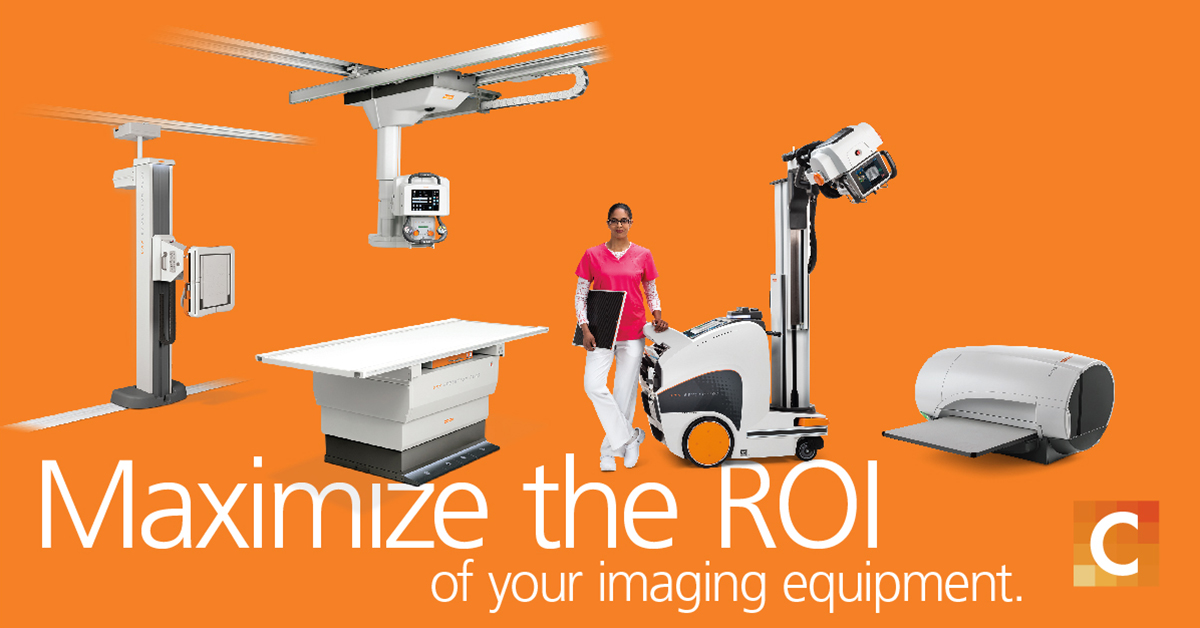
Reading Time: 9 minutes read
The images captured by X-ray equipment are often a critical first step to making a diagnosis and starting a care plan to improve a patient’s health. In addition, the revenue generated by the exams makes an important contribution to a facility’s financial viability. However, when the equipment is not working optimally, it can have a negative impact on the operation and finances of your imaging facility.
Proper care and maintenance of your X-ray equipment will help protect your financial investment and help you achieve optimal performance with your equipment. Following are 6 recommendations to maximize the ROI of your imaging equipment and keep it in optimal operation, thus obtaining better diagnostic results. These key recommendations are based on my 10 years of experience of servicing medical imaging equipment for Carestream customers.

Preventive maintenance is critical to help keep your equipment running at peak performance, in compliance of all regulatory and safety standards, and within the operating standards determined by the manufacturer. Only authorized and certified service personnel should perform work on the equipment.
Many imaging facilities enter into a technical service policy with their manufacturer for three good reasons. For one, your supplier’s personnel have been specially trained by the manufacturer and will have the necessary tools to carry out the corresponding calibrations. You won’t experience unnecessary delays like you might if an outside tech arrives without the proper tools.
Having a manufacturer-trained engineer also reduces the possibility of an untrained tech causing additional damage – with associated costs – to the equipment. It also helps getting your equipment up and running faster.
Second, with preventive maintenance, sometimes we can detect errors or component wear before they become a bigger problem.
Third, your service engineer can update your imaging equipment with the latest patches and updates that can correct and help improve the operation of your system.

There are various service plans with different coverage for X-ray equipment maintenance, so it is important to spend some time to find the one that best suits your needs and budget. You will need to consider your use of the system. If you have heavy volume, your components will likely wear out faster. Heavy workload also will require more hours of maintenance than lower volume equipment.
One of the most important and expensive components of X-ray machines is the X-ray tube. Make sure your service policy includes replacement of this critical part. Without it, your operations are shut down for the day.
After the maintenance is complete, your service technician should provide you with a detailed service report that lists all the maintenance that was completed.
As part of Carestream’s training, we make sure our service personnel have the latest service and technical bulletins and documentations for your products.
Proper use and manipulation of equipment is key to keep it working properly. Thus, it is important to keep your staff trained in its use. Training sessions are usually offered by your equipment provider. Carestream recommends refresher training at regular intervals to reinforce knowledge, especially in departments with frequent rotation of personnel.
Having a well-trained staff will help improve utilization and operational efficiency along with reduced opportunity of error, repeat exams and patient inconvenience.
The care and maintenance of components are often overlooked. However, they are also important to the full functioning of your system. Their downtime would negatively impact the ROI of your imaging equipment. Components include batteries, radiographic films, phosphor chassis and the detectors. Here are some recommendations that will help you keep your components in good condition and help provide the best image quality.
Detectors are mission-critical equipment. A broken DR detector can bring your streamlined workflow to a halt. Detectors are sensitive to drops so be sure to handle them with care. You might find this blog on 11 Tips to Protect Your Detectors helpful.
Care also must be taken to decrease the probability of damage to the detectors from liquids and chemicals. Use plastic bags in situations where the detectors might be exposed to fluids and chemicals to minimize problems and damage from filtration. (Watch our video on how to properly bag a detector.)
Detector batteries are an essential component in wireless detectors. Carestream detectors use lithium-ion batteries. We recommend not leaving them in a discharged state since they can be permanently damaged. You can recharge them frequently. (You do not need to worry about partial discharges.)
Batteries have a long useful life if the discharge depth is kept according to manufacturers’ guidelines. Be sure to read the specifications that come on the label. This will give you valuable information on the operating temperature and electrical specifications, among other things. If you have 2 or more batteries, we recommend that you rotate them for even life.
If you are using a CR system, the phosphor chassis requires periodic cleaning of the internal screens. This will reduce the artifacts that can be caused by dust and other elements on the screen. Be sure to use only liquids for cleaning that are recommended by the manufacturer. Also, note that the use of gauze or any other fabric that leaves residues is not recommended since they also can cause artifacts in the images.
And if you are using film, remember that radiographic films are very sensitive so it is important that you do not store them for an extended time. Check the expiration date periodically. Also check the labeling and manufacturer’s recommendations for the appropriate temperature range for storage.

Knowing the technical specifications of your equipment will provide you with valuable information on the capabilities of your system. For example, you don’t want to overuse your low-volume equipment. Low-volume equipment may process information quickly, but it was designed for a certain level of patient volume. Proper use of the equipment will allow you to considerably reduce the amount of corrective maintenance. You can find your equipment’s technical specifications in the user manual you received with the equipment.
You also should continually evaluate equipment usage against its technical specifications. Keeping track of your volume and noting any changes will be useful to you when it is time to purchase new equipment.
Another factor for X-ray equipment care is the operating environment. Always keep your equipment at the appropriate temperature. You can find the operating temperature recommended by the manufacturer in your operation manual.
You also need a good electrical system. Electrical problems that suddenly interrupt the operation of the equipment can cause damage to the application or programs that keep your equipment running. To help avoid this, reach out periodically to the appropriate person in your facility for periodic maintenance of your electrical network.
We also recommend that your equipment has a circuit breaker. This provides an uninterrupted supply of power even in the event of a grid failure. This will allow you to keep your equipment running long enough to complete the imaging exam that is under way, and then turn off the equipment properly afterward. You can purchase an authorized circuit breaker from the manufacturer of your X-ray equipment.
It also is important to keep your equipment in good physical appearance. You might not think that this impacts equipment performance, but it does.

The cleaning should focus on the exterior of the equipment: the covers and command and display controls (if equipped with your equipment). Use only the procedures and the chemical solutions authorized by the manufacturer. Use of unauthorized cleaning solutions may cause discoloration. Also, a poor cleaning procedure may result in chemical seepage on user interaction screens and impact their use. Consult your operation manual for more reference. If cleaning procedures are not specified or you no longer have your manual, contact your supplier. It also is important to turn X-ray equipment off before doing any cleaning to avoid electrical damage.
Equipment that is clean and free of any noticeable dirt or discoloration also is more comforting to patients. And of course, surface safety is even more critical with the continuing threat of COVID-19. In addition to surface cleaning, routine disinfectant must be done. Here are the guidelines for disinfecting Carestream equipment.
I hope you found these 6 recommendations for X-ray equipment care and maintenance useful. While some of them require a service contract with your manufacturer, others do not require technical knowledge and can be done by you and your staff. Routine preventive maintenance and care will help you minimize equipment downtime and maximize the ROI of your imaging equipment.

Jose Manuel Ordonez is a Remote Support Manager on Carestream’s service team in Latin America. He has 10 years of experience as a field engineer and specialist for Carestream’s medical imaging equipment.
#xrayequipmentcare #xrayequipmentmaintenance #xrayequipmentROI #carestreamcares #carestreamservice